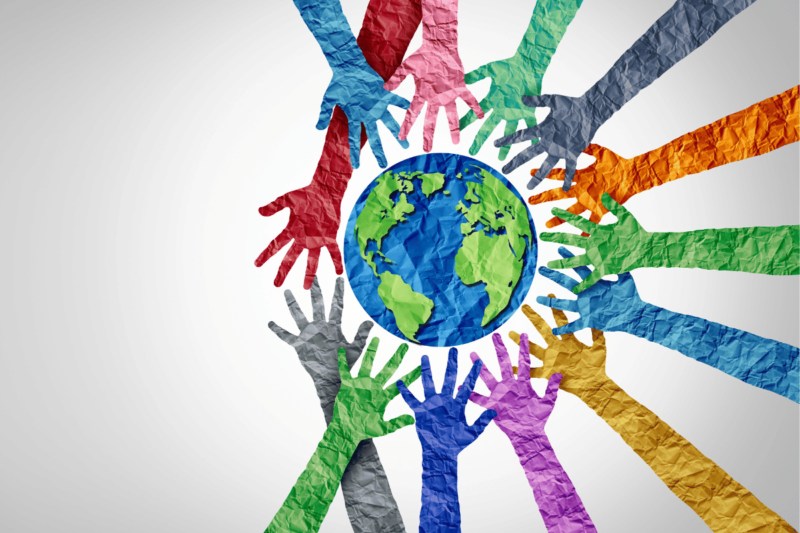
I believe in the power of nutritious food. I’m well-versed in what scientific research says about the role of the food we eat in preventing chronic disease. I know how nutrition plays an integral role in treating or managing certain health conditions.
I see, and experience, how eating food that nourishes the body while pleasing the taste buds can energize and delight us. But I also know that nutrition is not enough, because it doesn’t exist in a vacuum. I know that nutrition is not the sole, and often not the most important, determinant of our health.
What else is important? A secure job with benefits. A strong and vibrant community. Safe and affordable housing. An easy-to-navigate neighborhood with parks and community spaces. Access to healthy and affordable food. Opportunities to pursue education.
These are things we want for ourselves — and for others. But what you may not realize is that having, or not having, these “social determinants” affects our health. What if the root causes of chronic disease and poor health have less to do with our behaviors and personal choices than we think?
If you’ve never heard the term “social determinants of health,” a brief explanation is that they are the conditions in which we live, learn, work, and play.
These conditions, over time, lead to different levels of health risks, needs, and outcomes. These conditions affect every single one of us, because they are like a web.
If you have the privilege of a high level of education, you are more likely to have a high-earning job that offers health insurance. This allows you to afford good food, live in a safe neighborhood, get preventive health care, and partake of relaxing leisure activities. So, socioeconomic status is a key determinant, but so is stigma, discrimination and oppression based on race, gender or weight.

What are social determinants of health?
Social determinants of health (SDOH) are a subset of determinants of health — the personal, social, economic and environmental factors that influence health status. This broader group also includes:
- Government policies
- Individual behaviors: Diet, physical activity, alcohol, cigarette and other drug use, hand washing, seatbelt use and safe sex practices.
- Biological and genetic factors: Age, sex, HIV status, inherited conditions and genetic risks.
- Health services: Availability, affordability and/or insurance coverage and access to interpreters if needed
The World Health Organization (WHO) defines SDOH as “the conditions in which people are born, grow, live, work and age.” They include:
- Social factors such as educational and job opportunities, living wages, access to nutritious food and safe drinking water, discrimination, crime rates and exposure to violent behavior, social support and community inclusivity, early childhood experiences and development, exposure to media and technology, quality schools, transportation options, public safety, residential segregation and concentrated poverty.
- Place-based, or “physical” conditions, including the natural environment (plants, weather or climate change), the built environment (buildings and transportation), exposure to toxic substances or physical hazards, physical barriers (especially for people with disabilities), aesthetic elements (good lighting, trees, benches), and other aspects of our worksites, schools, housing, recreational settings and neighborhoods.
SDOH are shaped by distribution of money, power and resources at local, national and global levels. According to WHO, SDOH are responsible for most of the differences in health status within and between countries.
A change in one of these social factors can trigger many other changes that affect health. For example, education affects health literacy, but many other factors affect ability to attain an education, most obviously income, but also racism, sexism and other forms of stigma, bias and discrimination.

What effects do SDOH have on health?
While social factors may shape personal behaviors — for example, people with higher education and income may have more knowledge about nutrition and buy healthy food because they can easily access and afford it — this is only part of the picture.
- A 2011 meta-analysis found that the number of deaths in the U.S. in 2000 attributable to social factors — including low education, racial segregation and lack of social support — was comparable to the number of deaths due to disease and behaviors.
- A 2016 study found that states that spend more on social services and public health than they do on medical expenditures have substantially improved health outcomes, compared with states that do not, in areas including asthma, mental health, cancer, heart attacks, and type 2 diabetes.
A 2010 U.S. study found that health increases as social position — based on both socioeconomic status (SES) and race/ethnicity — increases. Notably, while those with the lowest income and education were consistently least healthy, groups with mid-range income and education levels were less healthy than the wealthiest and most educated groups.

Mapping SDOH pathways
As I mentioned, SDOH don’t operate in isolation. Together, they form a complex, multi-directional web. For example:
- Access to education means gaining skills that make it easier to find a good job that pays well, which makes it easier to pay your rent or mortgage and your bills.
- Having good and affordable housing frees up money to pay for food.
- Safe, well-connected streets make it easier for you to get where you need to go.
When you have all of these things, it’s easier to connect with your neighbors and your community. If you have kids, it makes it easier for you to help them do well in school.
On the other hand, poor health or lack of education can limit employment opportunities, which lowers income. Low income reduces access to healthcare, nutritious food and safe housing, which increases hardship. Hardship creates stress, which in turn can lead to unhealthy coping mechanisms such as substance abuse or overeating of unhealthy foods.
When you connect the dots, you can see that some pathways are direct and immediate. For example, exposure to pollution exacerbates asthma, which may result in more sick days and decreased physical activities.
You can also see that other pathways take longer to play out, with health effects taking years or decades to appear. For example, people who live in neighborhoods with little access to fresh produce or outdoor recreation but easy access to fast food are more likely to have poor nutrition and low levels of physical activity, which can contribute to chronic disease later in life.
We often (always?) think of behaviors as a cause of poor health, a mindset that contributes to the rise of “healthism” and an ascribing of moral value to health and health behaviors (you’re “good” if you’re healthy or at least try to be, but “bad” if you aren’t healthy and don’t pursue health “enough”).
However sometimes the pathways from SDOH to health outcomes are not only long and indirect, but they don’t even involve potentially modifiable nutrition and lifestyle behaviors. Chronic stress may be the link.

Allostatic load and epigenetics
Chronic exposure to social and environmental stressors — known as “allostatic load” — can lead to changes in the body. For example, stress can raise inflammation levels, and lower income and education contribute to high blood pressure and unhealthy cholesterol levels. All of these factors can increase the risk of cardiovascular disease.
Early childhood — a time of major brain development — is a critical window, and socioeconomic disadvantage during this window is linked to increased disease risk and decreased immunity later in life even if income and social position improves in adolescence and adulthood.
Epigenetics —the study of changes in gene expression that happen without changes to DNA yet can be passed from generation to generation — may explain other pathways, including changes in telomere length.
Telomeres are protective “caps” on the ends of chromosomes, and telomere shortening is considered a marker of cellular aging. Educational attainment, work schedules, perceived stress and whether someone works in a manual or non-manual job have all been linked to changes in telomere length.
The complex and often indirect nature of the pathways between SDOH and health outcomes, along with the length of time they take to develop, makes them nearly impossible to study using randomized controlled trials. In the case of epigenetics, these pathways may take more than one generation to manifest.
For example, deaths from heart disease declined dramatically between 1968 and 2014, but those rates of decline have been significantly slower among Black Americans in areas of the U.S. that had the highest concentration of slavery in 1860.

The impact of “weathering”
The disparities in maternal health outcomes between Black and white women in the U.S. at all income and education levels are both stunning and shocking. For example, Black women have significantly increased risk of the hypertensive disorder pre-eclampsia during pregnancy, which left untreated can kill both mother and baby.
These disparities may be due to “weathering,” early health deterioration due to social inequality. For example, white women in their 20s are more likely to give birth to a healthy baby than white teens, but the reverse is true for Black women — not that anyone’s suggesting the solution is for Black teens to have babies.
Weathering may also explain why Black women are two to three times more likely to develop harder-to-treat types of breast cancer, despite no evidence of pre-disposing genetic factors associated with African heritage.
The benefits of education and income don’t erase the effects of systemic racism and oppression. You can be doing the things that society places high value on, yet still endure the toxic stress of racism your entire life.
I vividly remember learning in one of my graduate classes at UW more than a decade ago that the reason that Black Americans have disproportionately high levels of high blood pressure has nothing to do with genetics, as was initially assumed. No, the cause was the cumulative toll of racism in its many forms, both overt and covert. And that was true regardless of education and income. All the good nutrition in the world can’t overcome that reality.

How SDOH affects nutrition
Evidence is clear that income level is associated with diet quality, but what’s less clear is why. We don’t really know how much of a role the price of nutritious foods and the time it takes to prepare them play.
A 2017 paper in the American Journal of Preventive Medicine suggests social factors that often coexist with low income — job, food and housing insecurity — along with resulting stress, poor sleep and mental burden, may have the greatest impact on what we eat.[23]
Also, conditions of uncertainty and threat can contribute to a scarcity mentality, which makes it hard to manage challenges, leading to a decline in diet quality when combined with low income. These conditions also activate hormones that regulate stress, appetite and hunger.
When children experience scarcity, they are more likely to be impulsive and vulnerable to temptation as adults, which can result in making food choices based on palatability and immediate gratification rather than nutrition, even when healthy food is available and affordable.
I constantly remind my clients that nutrition is only one contributor to health. Regular (and hopefully enjoyable) physical activity, adequate sleep, social connection, the ability to manage stress in healthy ways, having something to look forward to when you get up in the morning, those are all vital, too. But that assumes that someone has the privileges of equality and access to healthcare, and many Americans do not.

Why social justice matters for health
If we want to be healthier as a country, we need to widen our lens instead of playing the “personal responsibility” card and simply focusing on diet and lifestyle.
It’s sad that the words “diversity,” “equity” and “inclusion” have been turned dirty words by some political factions, but the reality is that we can improve health for ourselves and others by opposing stigma, discrimination and oppression in all its forms, in ways big and small, including its insidious presence in our institutions and systems.
Call these things out when you see them, and use curiosity and compassion to explore what assumptions you might be making about your health and other people’s health. This is a huge challenge, but if we don’t become part of the solution, then we remain part of the problem.
Disclaimer: All information provided here is of a general nature and is furnished only for educational purposes. This information is not to be taken as medical or other health advice pertaining to an individual’s specific health or medical condition. You agree that the use of this information is at your own risk.
Hi, I’m Carrie Dennett, MPH, RDN, a weight-inclusive registered dietitian, nutrition therapist and body image counselor. I offer compassionate, individualized care for adults of all ages, shapes, sizes and genders who want to break free from eating disorders, disordered eating or chronic dieting. If you need to learn how to manage IBS symptoms with food, or improve your nutrition and lifestyle habits to help manage a current health concern or simply support your overall health and well-being, I help people with that, too.
Need 1-on-1 help for your nutrition, eating, or body image concerns? Schedule a free 20-minute Discovery Call to talk about how I can help you and explore if we’re a good fit! I’m in-network with Regence BCBS, FirstChoice Health and Providence Health Plan, and can bill Blue Cross and/or Blue Shield insurances in many states. If I don’t take your insurance, I can help you seek reimbursement on your own. To learn more, explore my insurance and services areas page.
Want exclusive content on nutrition, health, diet culture and more, plus critiques of nutrition and health journalism? Subscribe to my Food Noise newsletter! 📣
 Print This Post
Print This Post






